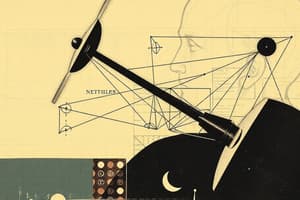Podcast
Questions and Answers
Which of Newton's laws states that an object in motion will stay in motion and an object at rest will stay at rest unless acted upon by an external force?
Which of Newton's laws states that an object in motion will stay in motion and an object at rest will stay at rest unless acted upon by an external force?
- Second law
- Third law
- First law (correct)
- Fourth law
According to Newton's second law of motion, what is the relationship between an object's mass, acceleration, and the force applied to it?
According to Newton's second law of motion, what is the relationship between an object's mass, acceleration, and the force applied to it?
- Acceleration is directly proportional to mass and force
- Force is inversely proportional to mass and acceleration
- Force is directly proportional to mass and acceleration (correct)
- Acceleration is inversely proportional to mass and force
In Newton's third law of motion, for every action, there is an equal and opposite reaction. Which of the following best describes this law?
In Newton's third law of motion, for every action, there is an equal and opposite reaction. Which of the following best describes this law?
- For every action, there is a reaction with a different direction
- For every force, there is a reaction force that is smaller in magnitude
- For every force, there is a reaction force that is greater in magnitude
- For every action, there is an equal and opposite reaction force (correct)
Which of Newton's laws states that the acceleration of an object is directly proportional to the net force acting on it and inversely proportional to its mass?
Which of Newton's laws states that the acceleration of an object is directly proportional to the net force acting on it and inversely proportional to its mass?
What does Newton's first law of motion state about the motion of an object?
What does Newton's first law of motion state about the motion of an object?
What does Newton's third law of motion imply about the forces between two interacting objects?
What does Newton's third law of motion imply about the forces between two interacting objects?
Flashcards are hidden until you start studying




